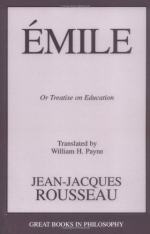In the same way it is unnecessary to take the precaution of heating the water; in fact among many races the new-born infants are bathed with no more ado in rivers or in the sea. Our children, made tender before birth by the softness of their parents, come into the world with a constitution already enfeebled, which cannot be at once exposed to all the trials required to restore it to health. Little by little they must be restored to their natural vigour. Begin then by following this custom, and leave it off gradually. Wash your children often, their dirty ways show the need of this. If they are only wiped their skin is injured; but as they grow stronger gradually reduce the heat of the water, till at last you bathe them winter and summer in cold, even in ice-cold water. To avoid risk this change must be slow, gradual, and imperceptible, so you may use the thermometer for exact measurements.
This habit of the bath, once established, should never be broken off, it must be kept up all through life. I value it not only on grounds of cleanliness and present health, but also as a wholesome means of making the muscles supple, and accustoming them to bear without risk or effort extremes of heat and cold. As he gets older I would have the child trained to bathe occasionally in hot water of every bearable degree, and often in every degree of cold water. Now water being a denser fluid touches us at more points than air, so that, having learnt to bear all the variations of temperature in water, we shall scarcely feel this of the air. [Footnote: Children in towns are stifled by being kept indoors and too much wrapped up. Those who control them have still to learn that fresh air, far from doing them harm, will make them strong, while hot air will make them weak, will give rise to fevers, and will eventually kill them.]
When the child draws its first breath do not confine it in tight wrappings. No cap, no bandages, nor swaddling clothes. Loose and flowing flannel wrappers, which leave its limbs free and are not too heavy to check his movements, not too warm to prevent his feeling the air. [Footnote: I say “cradle” using the common word for want of a better, though I am convinced that it is never necessary and often harmful to rock children in the cradle.] Put him in a big cradle, well padded, where he can move easily and safely. As he begins to grow stronger, let him crawl about the room; let him develop and stretch his tiny limbs; you will see him gain strength from day to day. Compare him with a well swaddled child of the same age and you will be surprised at their different rates of progress. [Footnote: The ancient Peruvians wrapped their children in loose swaddling bands, leaving the arms quite free. Later they placed them unswaddled in a hole in the ground, lined with cloths, so that the lower part of the body was in the hole, and their arms were free and they could move the head and bend the body at will without falling




